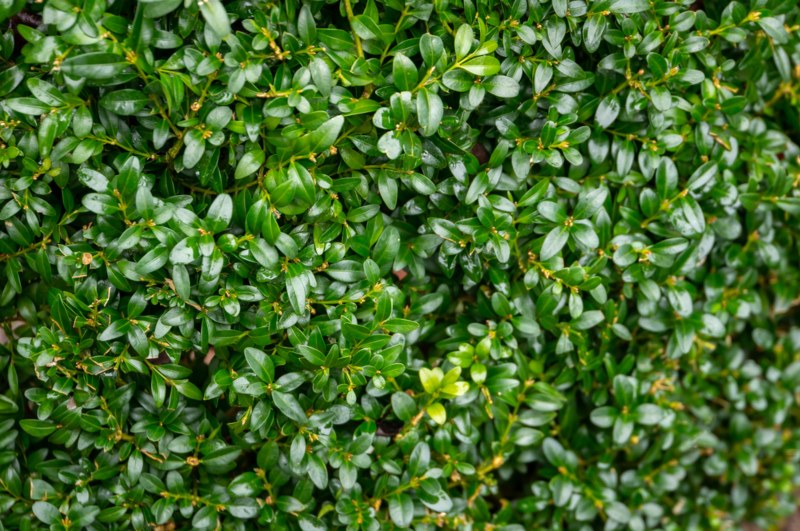
Whether you’re seeking privacy, looking to soften up the rough edges created by fencing, or simply looking to make your fenced-in yard more attractive, there are a number of plants that are perfect for planting along fence lines.
The aesthetic appeal of fence landscaping can make a huge difference in your home’s overall appearance as well as increase your home’s value. In fact, many of these shrubs are often used in lieu of a continued fence line.
In this guide, we cover 10 great options for fence line plants!
Clematis

Known as the queen of climbers, clematis is a lovely grower when planted near fences, trellises, or arbors. Its blossoms are purple, pink, blue or white, and they create a rich tapestry of color. These lovely plants grow upward and not out, making them perfect for even gardens that are quite small. Fencing is the perfect thing for these flower vines to climb upwards on, and even better when they spill over the top in their lovely royal purple shade. Clematis grows best in zones 4 through 9 and will perform best in full sunlight.
Cherry Laurel

Cheery laurel should be planted in rich, moist soil and will thrive in zones 5 through 9. Gardeners like cherry loyal because it will grow in most every light condition. This shrub blooms with dainty white flowers against evergreen leaves. It is known for its sweet fragrance that is especially potent in the spring as well as its small cherry-like fruits that attract birds and other small, friendly creatures.
Boxwood

Nicknamed the “aristocrat of hedging plants,” the boxwood is famously found in many formal gardens, often carved into geometric shapes or even topiaries. Its crisp, high hedges make it perfect for fence lining or as a privacy hedge, serving as a type of fencing itself due to the fact it keeps its foliage all year. This evergreen shrub grows well in hardiness zones 5 through 8.
Privet

Known as America’s fastest-growing hedge, the privet can grow up to 3 feet each year, averaging a height of 8 to 12 feet at its maturity. This makes the privet the perfect privacy hedge for fence lines, or even to be used in lieu of a fence altogether – hence the common term “privet fence.” The privet is an exceptionally popular plant addition to any fence line because of its highly attractive, dark green foliage. It will grow well in zones 4 through 8.
Fan Palm (Chamaerops humilis)

Also known as the European Fan Palm, this palm shrub has a crown of green, fan-shaped leaves that burst out of a singular trunk or a multi-trunk base. Among the hardiest of palms, the fan palm thrives in full sunlight and is tolerant to droughts and even extreme heat. It is mostly grown in zones 9-11.
Arborvitae

Arborvitaes grow in a pyramid-like shape that makes them perfect additions to any fence line, especially when planted in pairs at a fence opening, ending or beginning. These small evergreens keep their green foliage all year and grow best when they receive at least 6 hours of sunlight every day in zones 3 through 7.
Photinia

This ornamental evergreen shrub is commonly called the red tip photinia because of the striking, fiery red leaves that change to a dark green as the seasons change. It is very low-maintenance and has great aesthetic appeal when planted near any fence line or used as a solo privacy screen. Red tip photinias grow 6 to 12 feet in height and grow well in zones 7 through 9.
Euonymus

Euonymus is a flowering woodland plant that is also known as the wintercreeper that is generally a small tree or evergreen shrub. These are wonderful hedging plants and their leaves have a fascinating pattern that is a rich green on the inside, giving way to a creamy-white border. Euonymus requires little maintenance and grows well in full sun to even the heaviest shade.
Hicks Yew

This spirited evergreen shrub provides lush, year-round deep green color. Growing to be around 10 to 15 feet at maturity, it is the perfect addition to a fence, providing additional privacy while not overwhelming the landscape. Hick yew grows best in hardiness zones 5 through 8 and will grow well in sunlight or the shade.
Chocolate Vine (five-leaf akebia)

Bursting with purplish-brown dangling blooms and glossy dark green five-leaf foliage, this vine gets its name from the decadent chocolate aroma that the flowers give off during spring months. The chocolate vine will grow nicely in zones 4 through 8 when it receives at least six hours of sunshine a day.






